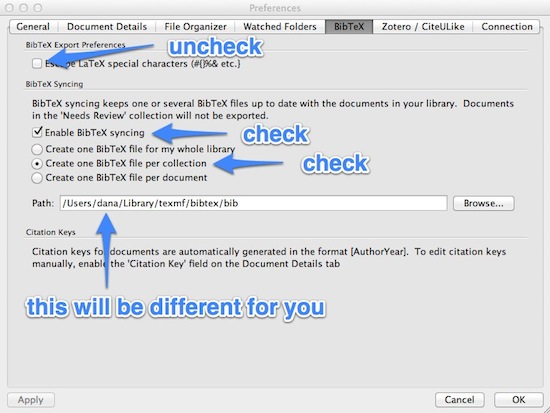Using Mendeley with BibTeX
Note: This post overlaps significantly with Mendeley’s blog post found here.
My current reference manager of choice is Mendeley, which is a free desktop and web solution designed for storing, annotating, and sharing research papers, discovering research data and collaborating online. It combines Mendeley Desktop, a PDF and reference management application (available for Mac, Linux, and Windows) with Mendeley Web, an online research paper management tool and social network for researchers. You can find a short YouTube video that describes what Mendeley is here.
For nearly all of my academic writing, I use LaTeX together with BibTeX. One of the many benefits of Mendeley is that it will automatically generate BibTeX files. However, at the time of writing this post (version 1.1.2 and earlier), integration with BibTeX is lacking in a few ways. In order for things to go smoothly, I suggest the following set up in Mendeley Desktop.

You want to uncheck the Escape LaTeX special characters box so that braces, backslashes, dollar signs, etc. don’t get clobbered by Mendeley when it generates the corresponding .bib files. You should choose Create one BibTeX file per collection. This generates one .bib file for each subcollection (folder or group) you create in Mendeley Desktop. If you don’t do this, Mendeley will create a duplicate entry in your synced .bib file for each entry appearing in a subcollection, which will in turn prevent LaTeX/BibTeX from compiling properly if you happen to cite one of the duplicate entries. I create a new subcollection for every document that I am writing that might require a bibliography.
Once you have got everything set up, it is really easy to incorporate Mendeley into your LaTeX writing workflow. If you want to cite a particular item, just click on it in Mendeley Desktop, hit command/control-k to copy the BibTeX citation key, then paste it into the appropriate location in your .tex file.
Dana C. Ernst
Mathematics & Teaching
Northern Arizona University
Flagstaff, AZ
Website
928.523.6852
BlueSky
Instagram
Facebook
Strava
GitHub
arXiv
ResearchGate
LinkedIn
Mendeley
Google Scholar
Impact Story
ORCID
Buy me a coffee
About This Site
This website was created using GitHub Pages and Jekyll together with Twitter Bootstrap.
Unless stated otherwise, content on this site is licensed under a Creative Commons Attribution-Share Alike 4.0 International License.
The views expressed on this site are my own and are not necessarily shared by my employer Northern Arizona University.
The source code is on GitHub.
Land Acknowledgement
Flagstaff and NAU sit at the base of the San Francisco Peaks, on homelands sacred to Native Americans throughout the region. The Peaks, which includes Humphreys Peak (12,633 feet), the highest point in Arizona, have religious significance to several Native American tribes. In particular, the Peaks form the Diné (Navajo) sacred mountain of the west, called Dook'o'oosłííd, which means "the summit that never melts". The Hopi name for the Peaks is Nuva'tukya'ovi, which translates to "place-of-snow-on-the-very-top". The land in the area surrounding Flagstaff is the ancestral homeland of the Hopi, Ndee/Nnēē (Western Apache), Yavapai, A:shiwi (Zuni Pueblo), and Diné (Navajo). We honor their past, present, and future generations, who have lived here for millennia and will forever call this place home.

